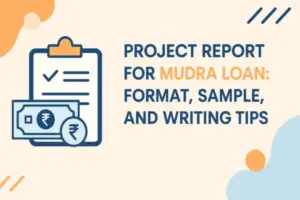Getting a Mudra loan rejected can be frustrating. This article dives into common reasons for rejection and how you can fix them to improve your chances next time.
Key Takeaways
- Common reasons for Mudra loan rejection include incomplete documentation, low credit scores, and unclear business plans.
- Applicants should prepare a detailed business plan, maintain a complete documentation checklist, and improve their credit scores to enhance approval chances.
- Utilizing support services like Bank Mitra and CSC can streamline the application process and improve the likelihood of loan approval.
Introduction
Mudra Loans, part of the Micro Units Development and Refinance Agency (MUDRA) scheme, are designed to support micro and small enterprises in India. The scheme is divided into three categories: Shishu, offering loans up to ₹50,000; Kishore, providing loans between ₹50,000 and ₹5 lakh; and Tarun, for loans ranging from ₹5 lakh to ₹10 lakh. These loans play a crucial role in fostering entrepreneurship and promoting financial inclusion.
Unlike secured loans, which require collateral or security as a condition for approval, Mudra loans are typically collateral-free. This means applicants are not required to pledge any collateral or provide security, making Mudra loans more accessible to small business owners who may not have significant assets.
Despite the growing number of applications, many applicants face rejection. Understanding the reasons behind these rejections is essential for improving one’s chances of approval. Knowing what mistakes to avoid and how to present a compelling application can make all the difference between success and failure.
Understanding Mudra Loan Eligibility Criteria
Before applying for a Mudra loan, it’s essential for small business owners to fully understand the eligibility criteria set by lenders. Mudra loans are specifically designed to support micro and small enterprises, and each loan category—Shishu, Kishor, and Tarun—has its own set of requirements and loan amounts, ranging from ₹50,000 to ₹10 lakhs.
To qualify for a Mudra loan, applicants must typically have a registered business, a satisfactory credit score, and demonstrate income stability. Lenders will carefully assess your credit history, review your financial statements, and evaluate your business plan to determine if you meet the eligibility criteria. A well-prepared business plan that outlines your business objectives, market strategy, and financial projections is crucial for loan approval.
Common mistakes, such as overlooking business registration or submitting incomplete financial statements, can lead to rejection. By understanding and meeting the eligibility criteria, applicants can avoid these pitfalls and improve their chances of securing a Mudra loan. Taking the time to assess your business’s readiness and ensuring all requirements are met will help you present a strong application to lenders.
Assessing Your Financial Health Before Applying
A critical step before submitting your Mudra loan application is to thoroughly assess your financial health. Lenders will evaluate your existing debts, cash flow, and credit score to determine your ability to repay the loan. A low credit score or a high debt to income ratio can be red flags that may result in loan rejection.
Small business owners should review their financial statements and consider consulting a financial advisor to identify areas for improvement. It’s important to address any outstanding debts, ensure your income is stable, and prepare for any industry-specific risks that could impact your business. By proactively managing your finances, you can strengthen your application and increase your chances of loan approval.
Understanding Mudra Loan Eligibility Criteria
Before applying for a Mudra loan, it’s essential for small business owners to fully understand the eligibility criteria set by lenders. Mudra loans are specifically designed to support micro and small enterprises, and each loan category—Shishu, Kishor, and Tarun—has its own set of requirements and loan amounts, ranging from ₹50,000 to ₹10 lakhs.
To qualify for a Mudra loan, applicants must typically have a registered business, a satisfactory credit score, and demonstrate income stability. Lenders will carefully assess your credit history, review your financial statements, and evaluate your business plan to determine if you meet the eligibility criteria. A well-prepared business plan that outlines your business objectives, market strategy, and financial projections is crucial for loan approval.
Common mistakes, such as overlooking business registration or submitting incomplete financial statements, can lead to rejection. By understanding and meeting the eligibility criteria, applicants can avoid these pitfalls and improve their chances of securing a Mudra loan. Taking the time to assess your business’s readiness and ensuring all requirements are met will help you present a strong application to lenders.
Assessing Your Financial Health Before Applying
A critical step before submitting your Mudra loan application is to thoroughly assess your financial health. Lenders will evaluate your existing debts, cash flow, and credit score to determine your ability to repay the loan. A low credit score or a high debt to income ratio can be red flags that may result in loan rejection.
Small business owners should review their financial statements and consider consulting a financial advisor to identify areas for improvement. It’s important to address any outstanding debts, ensure your income is stable, and prepare for any industry-specific risks that could impact your business. By proactively managing your finances, you can strengthen your application and increase your chances of loan approval.
Common Reasons for Mudra Loan Rejection

Understanding why Mudra Loans are commonly rejected can help applicants avoid these pitfalls. The primary reasons for rejection include incomplete documentation, low credit scores, and unclear business plans. Each of these factors can lead banks to reject your application if not adequately addressed.
Improper documentation is a frequent cause of loan rejections. Missing or incorrect documents, such as mismatched Aadhaar or PAN numbers, missing signatures, or unchecked fields, can lead to immediate rejection. Providing wrong information on the application can also cause the bank to reject your loan request. Additionally, applicants must meet the eligibility criteria and avoid applying for ineligible purposes, such as personal loans or luxury use, as Mudra loans are not meant for personal financial needs.
Other common reasons include poor or no credit score history, existing loan defaults, and internal bank policy or quota limitations for various reasons. Understanding these top reasons can help applicants prepare better and avoid making common mistakes.
Incomplete Documentation
Submitting complete and correct documentation is crucial to avoid immediate rejection of your Mudra loan application. It is important to accurately fill out all required forms and documents, as errors or omissions can result in delays or denial. For instance, the required documents for a Kishore Mudra loan include:
- PAN
- Aadhaar
- A 6-month bank statement
- Proof of business
- A simple business plan
Any mistake in these documents or in the way you fill the application forms can lead to a denial.
To prevent this, applicants should create a document checklist and verify all documents with their local bank to ensure correctness before applying for a Mudra loan. Careful filling of application details is essential to avoid mistakes that can lead to rejection. This proactive approach can significantly reduce the chances of rejection due to documentation errors.
Low Credit Score
A low credit score can severely impact your chances of securing a Mudra loan. Banks view a low credit score as a signal of financial irresponsibility, which increases the likelihood of loan rejection. Without a solid credit history, lenders have no way to assess your financial behavior, making them hesitant to approve your application.
Applicants with existing debts or multiple loans and a high debt to income ratio are viewed as higher risks, leading to potential rejection and financial strain. Having existing loans can negatively impact your eligibility, as lenders prefer applicants who have paid off previous loans or EMIs. To improve your chances, work on improving your credit score by clearing outstanding debts and making timely late payments.
Unclear Business Plan
A well-structured business plan is critical for the approval chances of Mudra loans. Banks need clarity on how the loan will be used and how it will generate returns. An unclear business plan can deter banks from approving the loan as they need assurances that the money will be used effectively.
Having a clear business plan that outlines your business model, target market, and financial projections can significantly enhance your chances of obtaining a Mudra loan. Entrepreneurs and small business owners should ensure their business plans are clear and include details to meet lender expectations.
Existing Debts and Poor Cash Flow
One of the most common reasons for Mudra loan rejection is the presence of high existing debts or poor cash flow. Lenders closely assess your ability to repay the loan, and if your financial statements show significant outstanding debts or inconsistent cash flow, it may signal financial strain.
To improve your chances of loan approval, focus on reducing existing debts and increasing your business income. Develop a realistic business plan that includes detailed financial projections, revenue estimates, and a clear repayment strategy. Demonstrating that you can manage your debts and maintain a healthy cash flow reassures lenders of your financial stability and commitment to repaying the loan.
High Industry Risk
The industry in which your business operates can also influence your Mudra loan approval. Some sectors, such as construction or nightlife, are considered high-risk due to market volatility or regulatory challenges. If your business falls into a high-risk category, lenders will scrutinize your application more closely.
To overcome this, small business owners should present a comprehensive business plan that highlights stable cash flow, effective risk management strategies, and a strong credit history. Conducting thorough market research and demonstrating a clear understanding of industry risks can help build lender confidence and improve your chances of loan approval.
Existing Debts and Poor Cash Flow
One of the most common reasons for Mudra loan rejection is the presence of high existing debts or poor cash flow. Lenders closely assess your ability to repay the loan, and if your financial statements show significant outstanding debts or inconsistent cash flow, it may signal financial strain.
To improve your chances of loan approval, focus on reducing existing debts and increasing your business income. Develop a realistic business plan that includes detailed financial projections, revenue estimates, and a clear repayment strategy. Demonstrating that you can manage your debts and maintain a healthy cash flow reassures lenders of your financial stability and commitment to repaying the loan.
High Industry Risk
The industry in which your business operates can also influence your Mudra loan approval. Some sectors, such as construction or nightlife, are considered high-risk due to market volatility or regulatory challenges. If your business falls into a high-risk category, lenders will scrutinize your application more closely.
To overcome this, small business owners should present a comprehensive business plan that highlights stable cash flow, effective risk management strategies, and a strong credit history. Conducting thorough market research and demonstrating a clear understanding of industry risks can help build lender confidence and improve your chances of loan approval.
Specific Bank Guidelines
Conducting thorough research on the specific requirements of different lenders can significantly enhance loan approval chances. Each bank may have unique eligibility criteria, such as specific income thresholds and credit score requirements. Familiarizing yourself with these guidelines can help you tailor your application to meet the bank’s expectations.
Adhering to specific bank guidelines is crucial to avoid loan rejections and improve chances of approval. Following these guidelines and understanding their requirements can lead to higher chances of securing a loan.
How to Avoid Mudra Loan Rejection

To avoid Mudra Loan rejection, applicants should:
- Submit complete applications, including maintaining accurate and thorough documentation.
- Prepare a well-structured business plan outlining the business model, target market, and financial projections to meet lender expectations.
- Improve their credit score by paying off debts and maintaining timely payments to enhance chances of a successful reapplication and to repay any outstanding obligations.
- Address any signs of financial instability, such as irregular income or unstable employment, as lenders may reject applications from those with unstable financial situations.
Different banks have unique eligibility criteria that applicants must meet to enhance their chances of loan approval, such as specific income thresholds and credit score requirements. File ITRs and maintain basic financial records to present a strong financial profile to pay a strong financial profile.
Apply only for eligible business uses and choose the right category: Shishu, Kishore, or Tarun. Getting help from Bank Mitra or CSC Centers can also provide valuable assistance in navigating the application process and ensuring all requirements are met.
Preparing a Detailed Business Plan
Lenders often require a basic business plan for larger loan amounts to assess viability. A detailed business plan helps justify the business loan amount and demonstrates planned utilization of funds in finance. This business loan application can make your application stronger and more compelling to lenders when seeking business loans.
The CSC network supports market research and business strategies, aiding applicants in preparing more robust loan proposals. Utilizing these resources can help you create a comprehensive and convincing business plan.
Ensuring Complete Documentation
Missing vital documents like business registration or income evidence can cause loan application rejection. It’s crucial to gather identification, financial statements, and business-related documents for the loan applications.
Maintaining a checklist of required documents, including proof of business and personal identification, can streamline the application process and prevent delays or rejections. This proactive approach ensures that all necessary documents are in order.
Improving Your Credit Profile
A CIBIL score below 650 significantly decreases the likelihood of loan approval. Banks prefer applicants with established credit histories, which impacts new borrower negatively.
Improving your credit score by paying off debts and maintaining timely payments can enhance your chances of a successful loan application. Regularly checking your credit report and addressing any discrepancies can also help improve your credit profile.
Demonstrating Strong Cash Flow and Debt Management
Lenders place significant emphasis on your ability to manage cash flow and debts effectively. Providing up-to-date financial statements, such as bank statements and tax returns, is essential to showcase your business’s financial health.
A clear business plan with realistic financial projections and a structured repayment plan will further demonstrate your capability to handle the loan responsibly. Maintaining a good credit score and avoiding late payments are also crucial, as lenders will assess your credit history to gauge your reliability. By presenting strong financial documentation and a well-thought-out business plan, you can significantly enhance your chances of Mudra loan approval.
Demonstrating Strong Cash Flow and Debt Management
Lenders place significant emphasis on your ability to manage cash flow and debts effectively. Providing up-to-date financial statements, such as bank statements and tax returns, is essential to showcase your business’s financial health.
A clear business plan with realistic financial projections and a structured repayment plan will further demonstrate your capability to handle the loan responsibly. Maintaining a good credit score and avoiding late payments are also crucial, as lenders will assess your credit history to gauge your reliability. By presenting strong financial documentation and a well-thought-out business plan, you can significantly enhance your chances of Mudra loan approval.
Steps to Take if Your Mudra Loan Application is Rejected

1. SEEK CLARIFICATION FROM THE BANK MANAGER: After a rejection, ask the bank manager for a detailed explanation of the reasons behind the rejection. Understanding these reasons is crucial to identify areas that need improvement.
2. ESCALATE TO HIGHER AUTHORITIES: If your concerns are not resolved at the branch level, consider escalating your case to higher authorities within the bank or financial institution. Approaching senior officials or higher management can sometimes help in getting your application reconsidered.
3. REVIEW YOUR LOAN APPLICATION: Carefully examine your loan application to spot any inaccuracies, missing information, or mistakes that may have contributed to the rejection.
4. GATHER ADDITIONAL DOCUMENTATION: If the rejection was due to incomplete or inadequate documentation, collect the necessary documents to strengthen your next application.
5. EXPLORE OTHER FINANCIAL INSTITUTIONS: Consider applying for a Mudra loan at other banks or microfinance institutions, as requirements and approval criteria may vary between lenders.
Utilizing Support Services
5. USE BANK MITRA AND CSC SERVICES: Support services like Bank Mitra and Common Service Centers (CSC) can guide you through the loan application process, helping ensure all documentation and eligibility criteria are met.
6. ACCESS DIRECT BANK REPRESENTATIVES: These support services often connect applicants directly with bank branch representatives, facilitating smoother and faster loan processing.
7. REDUCE PROCESSING TIME: Leveraging Bank Mitra or CSC assistance can significantly shorten the loan approval timeline, making the experience more efficient for applicants, as is common with most banks.
Tips to Boost Your Approval Chances
Register Your Business on Udyam/MSME Portal
Registering your business under the Udyam or MSME Portal is a crucial step to demonstrate your business’s credibility. This registration acts as an official recognition of your enterprise and can significantly improve your chances of loan approval. Many lenders prefer applicants with formal business registration as it assures them of the legitimacy and operational status of the business.
Use Digital Portals for Application Submission
Applying through digital portals like JanSamarth or Udyamimitra can streamline the loan application process. These platforms are designed to simplify documentation submission and reduce errors, making it easier for lenders to process your application quickly. Utilizing these portals also provides transparency and timely updates on your application status.
Attach a Comprehensive CMA or Project Report
Including a Credit Monitoring Arrangement (CMA) Report or a detailed project report with cost projections strengthens your application. These reports provide lenders with a clear understanding of your business finances, projected expenses, and expected returns. Additionally, providing valid quotations for equipment purchases or working capital needs adds credibility and justifies the loan amount requested.
Approach Public Sector Undertaking (PSU) Banks
PSU banks are often more favorable towards Mudra loan applications. These banks have dedicated schemes and processes that align well with Mudra loans, making them a reliable choice for applicants. Approaching PSU banks can increase your chances of approval due to their familiarity with government-backed loan schemes and their focus on supporting small businesses.
Importance of Business Registration

Business registration is important for eligibility in Mudra loans, as it can lead to better acceptance rates. While business registration is not mandatory for a Mudra loan, not having it can lead to rejection; it enhances approval chances.
Registering your business under Udyam or MSME can provide significant advantages that can improve your loan application prospects. A well-structured business plan can significantly enhance the likelihood of loan approval.
Choosing the Right Mudra Loan Category
The Mudra Loan Scheme offers loans up to ₹10 lakh under three categories: Shishu (up to ₹50,000), Kishore (₹50,000–₹5 lakh), and Tarun (₹5 lakh–₹10 lakh). These categories cater to different business needs and stages, making it crucial to select the appropriate one.
Shishu loans are designed for startups and small enterprises requiring funding of up to ₹50,000. Kishore loans cater to businesses looking for funding between ₹50,000 and ₹5 lakh. Tarun loans are meant for more established businesses that need between ₹5 lakh and ₹10 lakh.
Summary
In summary, understanding the common reasons for Mudra Loan rejections and taking proactive steps to avoid these pitfalls can significantly enhance your chances of approval. Ensuring complete documentation, maintaining a good credit score, and preparing a detailed business plan are critical components of a successful application.
By adhering to specific bank guidelines, utilizing support services like Bank Mitra and CSC, and choosing the right Mudra Loan category, applicants can navigate the loan application process with confidence. Remember, careful preparation and attention to detail can make all the difference in securing the funds needed to grow your business.
Frequently Asked Questions
What are the common reasons for Mudra Loan rejection?
Mudra Loan applications are commonly rejected due to incomplete documentation, low credit scores, unclear business plans, unverifiable income, ineligible purposes, existing loan defaults, and adherence to specific bank guidelines. Ensuring thoroughness and clarity in your application can significantly improve your chances of approval.
How can I improve my chances of Mudra Loan approval?
To enhance your chances of Mudra Loan approval, focus on thorough documentation, a strong credit score, and a comprehensive business plan, while ensuring timely income tax filings and appropriate registration under Udyam or MSME. Utilizing support services can also significantly aid your application process.
What should I do if my Mudra Loan application is rejected?
If your Mudra Loan application is rejected, inquire about the specific reasons, rectify any issues, gather any required documents, and consider reapplying after making the necessary adjustments. Additionally, exploring other financial institutions for a Mudra loan may be worthwhile.
Why is business registration important for Mudra Loans?
Business registration is crucial for Mudra Loans because it enhances eligibility and improves acceptance rates. By registering under Udyam or MSME, you can boost your chances of securing the loan.
How do I choose the right Mudra Loan category?
Choose the right Mudra Loan category based on your financial requirements and the stage of your business: Shishu for up to ₹50,000, Kishore for ₹50,000 to ₹5 lakh, and Tarun for ₹5 lakh to ₹10 lakh. Assess your goals to make an informed decision.
- Rejected Mudra Loan – What to Do Next? Appeal Process Explained
- Mudra Loan for Used Vehicle: Benefits, Interest Rates, and Eligibility Criteria
- Is the Mudra Loan Subsidy Real or Fake? Get the Facts Here
- Get Your Mudra Loan Approved: Write a Perfect Project Report with This Guide
- Mudra Loan Without CIBIL Score: How to Qualify and Apply
- Mudra Loan Without PAN Card: Eligibility & Application Process Explained
- Secure Your Future: Mudra Loan for Salaried Person Explained
- Mudra Loan for Senior Citizens or Retired Persons – Eligibility, Benefits & Myths
- Mudra Loan for Disabled Persons: Eligibility, Interest Rates, and Benefits
- Best Tips for Securing a Mudra Loan for SC ST Applicants
- Top Benefits of Mudra Loan for Women Entrepreneurs
- How to Get Mudra Loan for Franchise Business in India
- Mudra Loan for Home Business: How to Apply and Benefits
- Can I Get Mudra Loan Without GST or Udyam Registration?
- Mudra Loan for Amazon Seller, Dropshipping, and Affiliate Marketing – Is It Possible?
- Best Mudra Loan for Housewives – Empowering Women Across India
- Top Reasons for Mudra Loan Rejected and How to Fix Them
- Best Business Idea Under Mudra Loan 5 Lakh for 2025
- Mudra Loan for Used Machine: Eligibility, Interest Rates & Benefits



















